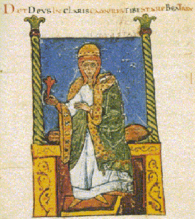Beatrice of Lorraine

For a clearer black-and-white image, see here

Beatrice of Bar (also Beatrix) (c. 1017 – 18 April 1076) was Regent of Tuscany in 1052-1076. She was the daughter of Frederick II, Duke of Upper Lorraine, who was also count of Bar, and Matilda of Swabia. She was married first to Boniface III of Tuscany and later to Godfrey of Lotharingia. Through her marriage to Boniface, she was marchioness of Tuscany from c. 1037/8 to her death in 1076.
Life
After her father died, she and her sister Sophie went to live with their mother's sister, Empress Gisela.[1]
c.1037/8, she became the second wife of Boniface III of Tuscany in a splendid ceremony.[2] She bore him the following children:[3]
- Beatrice (died 17 December 1053)
- Frederick (died July 1055), briefly successor before imprisonment
- Matilda (1046 – 24 July 1115),[4] successor as marchioness of Tuscany
Regency
With Boniface's death on 6 May 1052, Beatrice assumed the regency for her son Frederick.[5] In 1054, to give her son the protection she could not militarily provide, she married her cousin, Godfrey, former duke of Lower Lorraine.[6] However, in 1055, the Emperor Henry III arrested Beatrice for marrying a traitor. She was brought to Germany a prisoner while Frederick was summoned to Henry's court at Florence. He refused to go and died before any action was taken against him. The heir of Boniface was now his youngest daughter Matilda, who was imprisoned with her mother.[4]
On the death of Henry, Godfrey was reconciled with his heir, Henry IV, and exiled to Italy with his wife and stepdaughter. In January 1058, as a partisan of the newly elected Pope Nicholas II, Leo de Benedicto had the gates of the Leonine City thrown open for Godfrey and Beatrice. Godfrey immediately possessed the Tiber Island and attacked the Lateran, forcing Benedict X to flee on January 24. Beatrice and Godfrey were allied with the reformers, including Hildebrand and Pope Alexander II, against the emperor. In 1062, Beatrice tried to stop the Antipope Honorius II from reaching Rome, but she failed.
In 1069, Godfrey died. Matilda was of age, yet Beatrice continued to exercise government in her name until the day she died. On 29 August 1071, Beatrice founded the monastery Frassinoro at the Apennine pass of Foce della Radici.
Death
Beatrice died at Pisa on 18 April 1076.[7] She was buried in the Cathedral of Pisa, in a Late Roman sarcophagus, bearing reliefs illustrating the story of Hippolytus and Phaedra.[8] (Nicola Pisano adapted nude figures for his pulpit in the cathedral from the sarcophagus; they can still be seen in the cathedral.) Beatrice's sarcophagus is now located in the Campo Santo in the cathedral square. The inscription around the sarcophagus, which was added in the eleventh century for Beatrice, reads:
- Quamvis peccatrix sum domna vocata Beatrix
- In tumulo missa iaceo quæ comitissa
- Quilibet ergo pater noster, det pro mea anima ter.[9]
(“Although a sinner, I was called Lady Beatrice. I lie in this grave who was a countess. Whoever wishes may say three Our Fathers for my soul.”)
Notes
- ↑ Goez, Beatrix, p. 12; Kagay and Villalon, Crusaders, p.358
- ↑ Goez, Beatrix, pp. 14ff.
- ↑ Goez, Beatrix, p. 16
- 1 2 The Reform of the Church, J.P. Whitney, The Cambridge Medieval History, Vol. V, ed. J.R. Tanner, C.W. Previte-Orton, Z.N. Brooke, (Cambridge University Press, 1968), 31.
- ↑ Goez, Beatrix, p. 20
- ↑ Goez, Beatrix, p. 22.
- ↑ Goez, Beatrix, p. 32.
- ↑ Goez, Beatrix, p. 235.
- ↑ Bertolini, 'Beatrice di Lorena'
Sources
- Lexikon des Mittelalters: Beatrix von Ober-Lothringen, Markgräfin von Tuszien. (in German)
- M.G. Bertolini, Beatrice di Lorena, marchesa e duchessa di Toscana in Dizionario Biografico degli Italiani 7 (1970).
- E. Goez, Beatrix von Canossa und Tuszien. Eine Untersuchung zur Geschichte des 11. Jahrhunderts (Sigmaringen, 1995).
- Gregorovius, Ferdinand. Rome in the Middle Ages Vol. IV Part 1. 1905.
- Kagay & Villalon (2003). Crusaders, Condottieri, and Cannon: Medieval Warfare in Societies around the Mediterranean. Koninklijke Brill NV.
External links
- Women's Biography: Beatrice of Lorraine, duke of Tuscany, contains several letters sent and received by Beatrice.
- Medieval Lands Project
- Beatrix von Oberlothringen, Markgräfin von Tuszien (in German)